"Astronomy compels the soul to look upwards and leads us from this world to another." - Plato
147 posts
Latest Posts by intergalacticnerd - Page 4
tell the moon i love her
Dear moon, @324b2dun loves you. Happy Valentines!


Answer Time from Space!
I’m on day 321 of my #YearInSpace, and today I surpassed 500 days in space total. Let’s chat! Sat., Feb. 13 at 1:45 p.m. ET.

Gravitational Waves.
LIGO Gravitational Wave Chirp - Chirp pattern of gravitational waves detected by LIGO on September 14, 2015. Credit: LIGO http://www.ligo.org/

Excitement over tiny tiny ripples.
And so, gravitational wave astronomy is born. We live in exciting times!

Gravitational waves: discovery hailed as breakthrough of the century
Once again, Albert Einstein is proven right. Read more about this discovery in The Guardian.




Einstein’s gravitational waves found at last
One hundred years after Albert Einstein predicted the existence of gravitational waves, scientists have finally spotted these elusive ripples in space-time.
In a highly anticipated announcement, physicists with the Advanced Laser Interferometer Gravitational-Wave Observatory (LIGO) revealed on 11 February that their twin detectors have heard the gravitational ‘ringing’ produced by the collision of two black holes about 400 megaparsecs (1.3 billion light-years) from Earth.
“Ladies and gentlemen, we have detected gravitational waves,” David Reitze, the executive director of the LIGO Laboratory, said at a Washington DC press conference. “We did it!”
Continue reading via source: Nature
Infographic: Nik Spencer/Nature
By now you’ve probably heard the news that gravitational waves have been directly observed for the first time ever. Are you excited?

Our friends at PBS Space Time are pretty excited about it too, and they’ve put together an awesome video explaining the physics behind this discovery and why it’s so important.

Gravitational Waves Exist: The Inside Story of How Scientists Finally Found Them
How a group of scientists proved Einstein right—and expanded our view of the universe.

Black Holes are not so Black (Part 3) - Gravitational Waves
The existence of Gravitational Waves have been confirmed. But you probably have heard that. In this post, we will break down this profound discovery into comprehend-able chunks.
This is going to be a amazing journey. Ready ?
Redefining Gravity
When we usually talk of Gravitation we are bound to think like Newton, where objects are assumed to exerting a force upon each other.
Like imaginary arrows of force in space. But this picture, although good for high school crumbled, with the advent of Einstein’s theory of Relativity.

What is the Space-Time Fabric?
Think of space-time fabric as an actual cloth of fabric. ( An analogy )
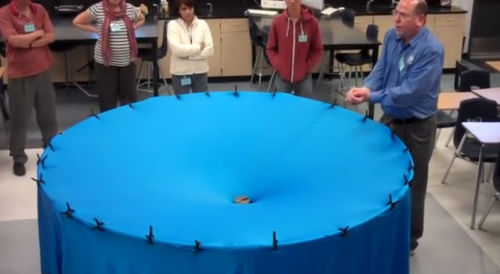
When you place an object on the fabric, the cloth curves. This is exactly what happens in the solar system as well.

The sun with such a huge mass bends the space-time fabric. And the earth and all the planets are kept in orbit by following this curvature that has been made by the sun.
Attributing to the various masses of objects, the way they bend this fabric also varies.
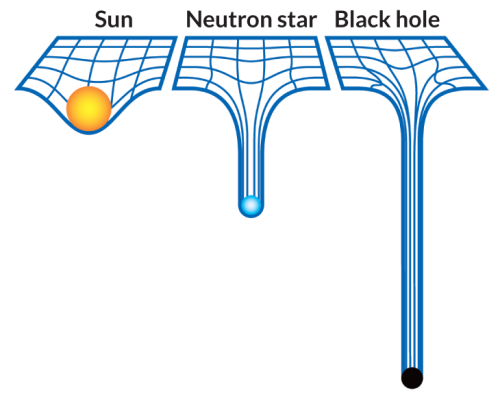
What are Gravitational Waves?
If you drop an object in a medium such as water, they produce ripples that propagate as waves through the medium.

Similarly, Gravitational waves are ripples in space-time fabric produced when you drag heavy objects through space time.
And the nature of these waves is that they don’t require a medium to propagate.
How do you make one?
Everything with mass/energy can create these waves.

Source
Two persons dancing around each other in space too can create gravitational waves. But the waves would be extremely faint.
You need something big and massive accelerating through space-time in order to even detect them.

And orbiting binary stars/black holes are valuable in this retrospect.
How can you detect them?
Let’s turn to the problem to detecting them assuming you do find binary stars/black-holes in the wondrous space to suite your needs.
Well, for starters you cannot use rocks/ rulers to measure them because as the space expands and contracts, so do the rocks. ( the distances will remain same in both the cases )

Here’s where the high school fact that the speed of Light is a constant no matter what plays an important and pivotal role.
If the space expands, the time taken for light to reach from A to B would be longer. And if it contracts, the time taken for it to reach from A to B would be smaller.

PC: PHDComics
By allowing the light waves from the contraction and expansion to interfere with each other, such as done in any interferometry experiment we can detect the expansion or contraction. Voila!
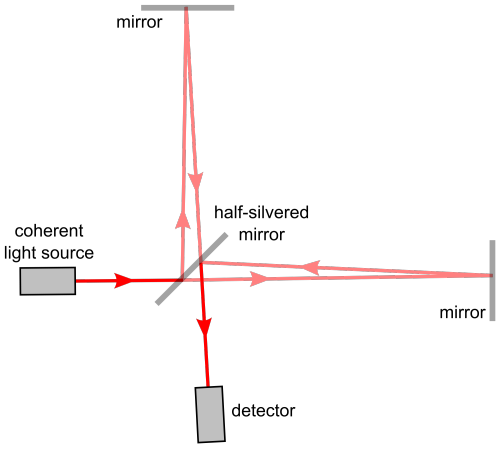
And this is exactly what they did! ( on a macroscopic level ) at LIGO (Laser Interferometer Gravitational-Wave Observatory)
14 September 2015

Two Black Holes with masses of 29 and 36 solar masses merged together some 1.3 Billion light years away.
Two Black Holes colliding is the header animation of the ‘Black Holes are not so Black Series’, in case if you haven’t noticed.

The merger of these two black holes results in the emission of energy equivalent to 3 solar masses as Gravitational Waves.
This signal was seen by both LIGO detectors, in Livingston and Hanford, with a time difference of 7 milliseconds.
And with the measurement of this time difference, physicists have pronounced the existence of Gravitational Waves.
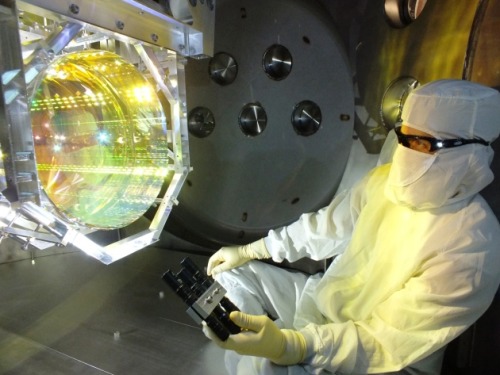
Source
All this is most certainly easily said than done and requires meticulous and extensive research, not to mention highly sensitive instruments.
Had they not have measured this time difference, we might have had to wait for the merger for more massive black holes to collide and maybe even build more sensitive instruments to detect these waves.
And Einstein predicted this a 100 years back!
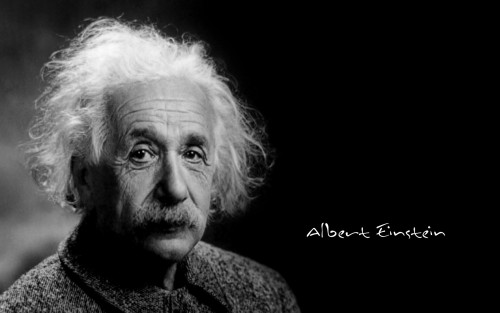
Mind Blown!
Note: Hope you are able to understand and appreciate the profundity of the discovery done by mankind.
** All animations used here are merely for Educational purposes. If you have any issues, please write to us at : 153armstrong@gmail.com

Einstein presented his theory of relativity in 1916, but for an entire century nobody could find physical proof of black holes. In 2016, scientists finally detected gravitational waves that emitted from 2 black holes colliding, proving that such things not only exist, but that Einstein was right all along. Source
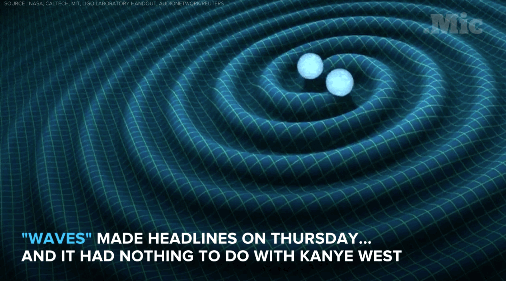

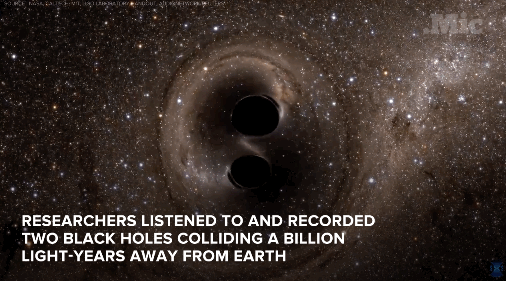


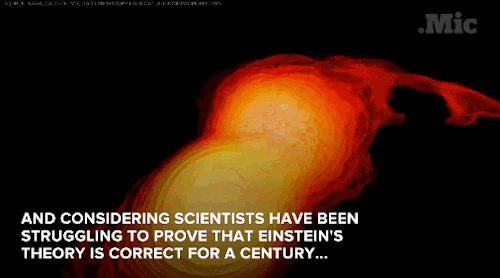

Gravitational waves are real — and that’s a huge f***ing deal!
A century ago, Albert Einstein theorized there was such a thing as a fabric of space and time — that the universe was malleable, and that large objects and events would cause it to bend.
He was right. From studying the signals emanating from the merging of two black holes — have separate masses equal to 36 and 29 suns — scientists with the Laser Interferometer Gravitational-Wave Observatory were able to observe gravitational waves. Their measurements matched expectations of what Einstein predicted in his General Theory of Relativity.
Follow @the-future-now

Infant Star’s Artistic Outburst
The artistic outburst of an extremely young star, in the earliest phase of formation, is captured in this spectacular image from the NASA/ESA Hubble Space Telescope. The colourful wisps, found in the lower left of the image, are painted onto the sky by a young star cocooned in the partially illuminated cloud of obscuring dust seen to the upper right.
Pictured punching through the enshrouding dust is an extremely hot, blue jet of gas released by the young star. As this jet speeds through space, it collides with cooler surrounding material. The result is the colourful object to the lower left, produced as the cooler material is heated by the jet (opo9524a, potw1307a).
This wispy object is known as HH34 and it is an example of a Herbig–Haro (HH) object. It resides approximately 1400 light-years away near the Orion Nebula, a large star formation region within the Milky Way. HH objects exist for a cosmically brief time — typically thousands of years — with changes seen in observations taken only a few years apart (heic1113).
Credit: ESA/Hubble & NASA
deep sea documentaries have me like




Highest point in Georgia


This is Kjell Lindgren. He’s a NASA astronaut who just got back from 5 months on the International Space Station. There are two reasons why this picture is hilarious:
His wife is flawless and makes bad space puns to make him do household chores.
I have that shirt. Thousands of people have that shirt. That shirt is available at Target. Which means actual astronaut Kjell Lindgren, with his wardrobe already full of NASA-issued and logo-emblazoned clothes, was at Target, saw a NASA shirt, and was like, “Yes, I am buying this because this is what I want to spend my actual astronaut salary on.”
tl;dr NASA employs a bunch of fucking nerds

Astronauts play ping pong in space using water and hydrophobic padels
[video]

Saturn and its largest moon reflect their true colors http://ift.tt/1lnhm8l

Southern Cross by Carlos Fairbairn
js



We’ve always defined ourselves by the ability to overcome the impossible. And we count these moments. These moments when we dare to aim higher, to break barriers, to reach for the stars, to make the unknown known. We count these moments as our proudest achievements. But we lost all that. Or perhaps we’ve just forgotten that we are still pioneers. And we’ve barely begun. And that our greatest accomplishments cannot be behind us, because our destiny lies above us. - Interstellar, 2014.






Interstellar 2014









We’ve always defined ourselves by the ability to overcome the impossible. And we count these moments. These moments when we dare to aim higher, to break barriers, to reach for the stars, to make the unknown known. We count these moments as our proudest achievements. But we lost all that. Or perhaps we’ve just forgotten that we are still pioneers. And we’ve barely begun. And that our greatest accomplishments cannot be behind us, because our destiny lies above us.
Interstellar (2014) dir. Christopher Nolan








“We used to look up at the sky and wonder at our place in the stars. Now we just look down, and worry about our place in the dirt.”














We used to look up at the sky and wonder at our place in the stars. Now we just look down, and worry about our place in the dirt.
why am i sad
I don’t have any answer to this but I hope you feel better :’( But here is a great example of astronomy and how awesome humanity can be

Elon Musk has released this video of today’s Falcon 9 landing attempt. The first stage of the JASON-3 mission’s Falcon 9 touched down on the surface of the Autonomous Spaceport Drone Ship around ten minutes after today’s 1:42pm EST launch.
However, according to Musk, landing strut #3 didn’t lock in to place properly, and vehicle toppled over. In this newly-released video, the Falcon 9 can be seen gently coming to land on the desk of the ship, falling on the improperly secured leg shortly thereafter.
Musk also said that preliminary data suggests ice build up from foggy launch conditions may have caused the strut to improperly secure upon deployment.


T-2 hours - JASON-3 and Falcon 9 stand tall on the west coast. For the second time in its history, a SpaceX Falcon 9 v1.1 rocket stands at Vandenberg Air Force Base’s SLC-4E ready for launch. The 224 foot tall rocket will carry the joint NASA/NOAA JASON-3 satellite to study Earth’s oceans. Of the 20 flights of the Falcon 9 to date, all but one has occurred from Cape Canaveral’s SLC-40. The inaugural flight of Falcon 9 v1.1, Cassiope in September 2013, was also the debut of the vehicle on the west coast. The JASON-3 mission will see the final v1.1 Falcon 9 performing the vehicle’s second west coast flight. Liftoff will occur in the middle of a 30-second launch window, at 1:42 pm EST (10:42 am PST). NASA TV coverage started at 11 am EST. Watch the launch live here. p/c: SpaceX/NASA
Cassini Top 10 Images and Science Results of 2015
As our Cassini spacecraft enters its final 20 months before its plunge into Saturn, the mission’s science team has selected their top 10 images from 2015 (above), a year of historic discoveries, as well as the top science results (below). Take a look:
1. First Deep Seafloor Hydrothermal Vents Found Beyond Earth

Cassini found the first evidence of active hot-water chemistry beyond planet Earth. An extensive, four-year analysis of data from the spacecraft, computer simulations and laboratory experiments led researchers to the conclusion the tiny silica (SiCO2) grains most likely form when hot water containing dissolved minerals from the moon’s rocky interior travels upward, coming into contact with cooler water.
2. Global Ocean Beneath Enceladus’ Surface

A global ocean lies beneath the icy crust of Saturn’s geologically active moon Enceladus. Scientists analyzed more than seven years’ worth of images of Enceladus taken by the spacecraft, which has been orbiting Saturn since mid-2004. As a result, they found Enceladus has a tiny, but measurable wobble as it orbits Saturn. This proves that there must be a global layer of liquid separating the surface from the core.
3. Titan Observed Outside of Saturnian Magnetosphere

During Cassini’s flyby of Titan, the giant moon happened to be on the sunward side of Saturn when a powerful outburst of solar activity reached the planet. The strong surge in the solar wind so compressed the sun-facing side of Saturn’s magnetosphere that the bubble’s outer edge was pushed inside the orbit of Titan. This left the moon exposed to, and unprotected from, the raging stream of energetic solar particles. The region of space dominated by Saturn’s magnetic field is called the magnetosphere.
4. Density of a Ring Particles May Indicate Recent Origins

Saturn’s A ring was found to be warmer than expected at the planet’s equinox, and also had an unusually large thermal asymmetry about the equinox. This could be due to the A ring being mostly composed of denser particles made primarily of solid ice, with a thin top layer of fluffy regolith.
5. Titan Southern Polar Ice Cloud

Scientists have detected a monstrous new cloud of frozen compounds in Titan’s low- to mid-stratosphere – a stable atmospheric region above the troposphere, or active weather layer.
6. Curtain Vents on Enceladus?

New research using data from Cassini suggests most of the eruptions from Saturn’s moon Enceladus might actually be diffuse curtains rather than discrete jets. Many features that appear to be individuals jets of material erupting along the length of prominent “tiger stripe” fractures in the moon’s south polar region might be phantoms created by an optical illusion, according to the new study.
7. Discovery of Tethys Red Arcs

Like graffiti sprayed by an unknown artist, unexplained arc-shaped, reddish streaks are visible on the surface of Saturn’s icy moon Tethys. The origin of the features and their reddish color is a mystery to scientists.
8. Saturn’s 30-year Giant Storms Powered by Water Convection

Changes in temperature and the composition of the hydrogen-laden air within the remnants of a giant storm system on Saturn reveal that air was lofted more than 120 miles in altitude from the deeper water condensation levels.
9. Seasonal Change Seen at Saturn’s Poles

Saturn’s polar regions have displayed extreme seasonal changes during Cassini’s decade-long watch, providing the most comprehensive view ever obtained of seasonal change on a giant planet.
10. Huygens Probe Imaging Mosaic of Titan’s Surface and Descent Movie

Ten years ago, an explorer from Earth, the Huygens probe, was released from the Cassini spacecraft and parachuted into the haze of an alien moon toward an uncertain fate. After a gentle descent lasting more than two hours, it landed with a thud on a frigid floodplain on Titan, surrounded by icy cobblestones.
Make sure to follow us on Tumblr for your regular dose of space: http://nasa.tumblr.com
